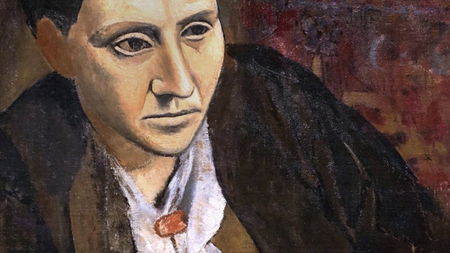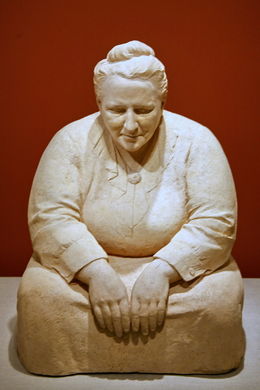Gertrude Stein: Difference between revisions
imported>Pat Palmer |
imported>Pat Palmer (→Least famous work: simplifying the explanation) |
||
| Line 12: | Line 12: | ||
Stein's least famous work was published posthumously in 1947 and was entitled ''Four in America''<ref>''Four in America'' was published in 1947 by Yale University Press. The book includes a 26-page introduction by playwright [[Thornton Wilder]].</ref>. As of 2020, ''Four in America'' is out of print, has never been digitized, and is likely to be found in only two or three libraries in the United States<ref>A copy of ''Four in America'' exists in the <span class="newtab">[https://www.freelibrary.org/ Philadelphia Free Library]</span>, and also in the <span class="newtab">[https://library.princeton.edu/ Princeton University Library]</span></ref>. Even used copies via the internet are difficult to come by. The book consisted of four sections, purporting to be about “Wilbur Wright”, "Grant", “Henry James” and “George Washington”. | Stein's least famous work was published posthumously in 1947 and was entitled ''Four in America''<ref>''Four in America'' was published in 1947 by Yale University Press. The book includes a 26-page introduction by playwright [[Thornton Wilder]].</ref>. As of 2020, ''Four in America'' is out of print, has never been digitized, and is likely to be found in only two or three libraries in the United States<ref>A copy of ''Four in America'' exists in the <span class="newtab">[https://www.freelibrary.org/ Philadelphia Free Library]</span>, and also in the <span class="newtab">[https://library.princeton.edu/ Princeton University Library]</span></ref>. Even used copies via the internet are difficult to come by. The book consisted of four sections, purporting to be about “Wilbur Wright”, "Grant", “Henry James” and “George Washington”. | ||
''Four in America'' is now noteworthy because a single sentence of it has been widely misquoted and misinterpreted multiple times on the internet, all without any reference to its actual source. Internet quotes claim that Stein said she "admired Ulysses S. Grant". Others claim that Stein said she could not “think of Grant without weeping”. The actual sentence Stein wrote is to be found in the quarter of ''Four in America'' allegedly about Grant, on its last page, | ''Four in America'' is now noteworthy because a single sentence of it has been widely misquoted and misinterpreted multiple times on the internet, all without any reference to its actual source. Internet quotes claim that Stein said she "admired Ulysses S. Grant". Others claim that Stein said she could not “think of Grant without weeping”. The actual sentence Stein wrote is to be found in the quarter of ''Four in America'' allegedly about Grant, on its last page, atop the following abstruse paragraph: | ||
{{Image|Terra cotta stein.jpg|left|260px|[[Jo Davidson]]'s life-size terra cotta sculpture of Gertrude Stein created in Paris in 1923, now in the Smithsonian National Portrait Gallery. A bronze cast of this sculture was made in 1991 for Bryant Park, Manhattan, New York City. "There was an eternal quality about her," sculptor Jo Davidson wrote. "She somehow symbolized wisdom." He depicted her here as "a sort of modern Buddha." }} | {{Image|Terra cotta stein.jpg|left|260px|[[Jo Davidson]]'s life-size terra cotta sculpture of Gertrude Stein created in Paris in 1923, now in the Smithsonian National Portrait Gallery. A bronze cast of this sculture was made in 1991 for Bryant Park, Manhattan, New York City. "There was an eternal quality about her," sculptor Jo Davidson wrote. "She somehow symbolized wisdom." He depicted her here as "a sort of modern Buddha." }} | ||
{|align="center" cellpadding="10" style="background-color:#FFFFCC; width:80%; border: 1px solid #aaa; margin:20px; font-size: 95%;" | {|align="center" cellpadding="10" style="background-color:#FFFFCC; width:80%; border: 1px solid #aaa; margin:20px; font-size: 95%;" | ||
Revision as of 08:41, 6 February 2021
Authors [about]:
join in to develop this article! |

Gertrude Stein (1874 - 1946) was an American author who lived in Paris, France, and is best remembered for hob-nobbing with several famous writers and artists while living in Paris, and for creating deliberate linguistic conundrums. Anyone wanting to know about Gertrude Stein's childhood, education, or what she liked for dinner, is welcome to hop over to Wikipedia and find it out there. They'll also have a list of the famous writers and artists who attended her salon, and fill you in on her personal life, including her sexual orientation (as if that has anything to do with anything literary). But I focus here on the widespread difficulty people have in reading Stein: they simply don't know what to make of what she wrote. This phenomenon is so strong that even English literature majors in college have often never been required to read a single work by Stein. It seems that Stein is a much talked about and seldom read writer. Famous for various odd quotations, Stein may also be the most misquoted and least read writer of the English language. Most of her quotes appearing on the internet lack a specific citation, so their source can be difficult to track down.
Most famous work
Stein's most famous work was a best seller published in 1933, The Autobiography of Alice B. Toklas, and it shows early traces of the kind of confounding language that has caused Gertrude Stein to be remembered nearly a century later.
Least famous work
Stein's least famous work was published posthumously in 1947 and was entitled Four in America[1]. As of 2020, Four in America is out of print, has never been digitized, and is likely to be found in only two or three libraries in the United States[2]. Even used copies via the internet are difficult to come by. The book consisted of four sections, purporting to be about “Wilbur Wright”, "Grant", “Henry James” and “George Washington”.
Four in America is now noteworthy because a single sentence of it has been widely misquoted and misinterpreted multiple times on the internet, all without any reference to its actual source. Internet quotes claim that Stein said she "admired Ulysses S. Grant". Others claim that Stein said she could not “think of Grant without weeping”. The actual sentence Stein wrote is to be found in the quarter of Four in America allegedly about Grant, on its last page, atop the following abstruse paragraph:

|
I cannot think of Ulysses Simpson Grant without tears. He was so what shall it be not by any night not by any day not by any light not by any way, but Ulysses Simpson Grant, which one is, that one is, who can come that one can come, for which they come not of for which they come but they can in that case but which they can in that case can place, I place him there. Do you too. Do you two place him there which do you do. I do I place him there. I which I place him there, not only for me to be me, I am an American which if which I can be only I know, I know all about sitting and standing but I do not sit and stand in the way not yet nor has been. From Four in America, page 81, by Gertrude Stein (1947). |
An attempt to make sense of the above paragraph can be found in Four in America's 26-page introduction by Thornton Wilder. He provides an explanation for Stein’s mangled, rebellious and challenging use of language. Per Wilder, Stein believed that we are now living in “end times” where language has become superficial in effect, and normal use of language does not reach the real person inside each of us. Thus (surmises Wilder), Stein tried a variety of unorthodox mechanisms to cut through our mental fog, to make us sit up and think differently, to jar us out of complacency, to challenge what we really know. Possibly, to want to read this book, wrote Wilder, requires a kind spiritual readiness.
Other popular quotes from Gertrude Stein's work
Stein was the author of a number of brief quotes that became very popular, but which also came from works filled with nearly incomprehensible language. Most people using these quotes name Stein as the author, but not the work from which they came. There is an attempt afoot to try and locate the actual sources for each of the quotes below.
|
A vegetable garden in the beginning looks so promising and then after all little by little it grows nothing but vegetables, nothing, nothing but vegetables. From Wars I Have Seen, page 39, by Gertrude Stein (1945). |
|
Let me listen to me and not to them. From Stanzas in Meditation Stanza VII, by Gertrude Stein (1932)[3] |
The following is frequently misquoted as A rose is a rose is a rose.
|
Rose is a rose is a rose is a rose.[4] From the poem "Sacred Emily", by Gertrude Stein (first appearance 1913)[5] |
|
Whenever you get there, there is no there there. From ?, page ?, by Gertrude Stein (19??). |
|
Nothing is really so very frightening when everything is so very dangerous. From ?, page ?, by Gertrude Stein (19??). |
|
It takes a heap of loafing to write a book. From ?, page ?, by Gertrude Stein (19??). |
|
Let me listen to me and not to them. From ?, page ?, by Gertrude Stein (19??). |
There ain't no answer. There ain't gonna be any answer. There never has been an answer. There's your answer. From ?, page ?, by Gertrude Stein (19??). |
Notes
- ↑ Four in America was published in 1947 by Yale University Press. The book includes a 26-page introduction by playwright Thornton Wilder.
- ↑ A copy of Four in America exists in the Philadelphia Free Library, and also in the Princeton University Library
- ↑ More about "Let me listen to me..." is at the Google Books page for Stanzas in Meditation: The Corrected Edition by Gertrude Stein, Yale University Press, Jan 17, 2012; last access 2/5/2021
- ↑ From Project Gutenberg: Geography and Plays by Gertrude Stein, last access 2/6/2021
- ↑ More about "Rose is a rose is a rose" is in the University of Pennsylvania's Electronic Poetry Center, last access 2-5-2021